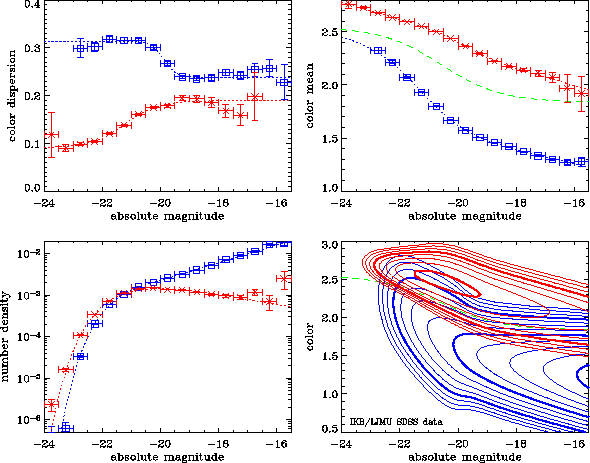Quantifying the bimodal color-magnitude distribution of galaxies
Baldry et al. 2004, published in ApJ, Vol. 600, pp. 681-694 (link:
ADS).
Abstract
We analyse the bivariate distribution, in color versus absolute magnitude (u-r
vs. M_r), of a low redshift sample of galaxies from the Sloan Digital Sky
Survey (SDSS; 2400 deg^2, 0.004 < z < 0.08, -23.5 < M_r < -15.5). We trace the
bimodality of the distribution from luminous to faint galaxies by fitting
double-Gaussians to the color functions separated in absolute magnitude
bins. Color-magnitude (CM) relations are obtained for red and blue
distributions (early- and late-type, predominantly field, galaxies) without
using any cut in morphology. Instead, the analysis is based on the assumption
of normal Gaussian distributions in color. We find that the CM relations are
well fit by a straight line plus a tanh function. Both relations can be
described by a shallow CM trend (slopes of about -0.04, -0.05) plus a steeper
transition in the average galaxy properties over about two magnitudes. The
midpoints of the transitions (M_r=-19.8 and -20.8 for the red and blue
distributions, respectively) occur around 2x10^10 M_solar after converting
luminosities to stellar mass. Separate luminosity functions are obtained for
the two distributions. The red distribution has a more luminous characteristic
magnitude and a shallower faint-end slope (M^*=-21.5, alpha=-0.8) compared to
the blue distribution (alpha=-1.3 depending on the parameterization). These
are approximately converted to galaxy stellar mass functions. The red
distribution galaxies have a higher number density per magnitude for masses
greater than about 3x10^10 M_solar. Using a simple merger model, we show that
the differences between the two functions are consistent with the red
distribution being formed from major galaxy mergers.
Data:
Links: - return to my home page;
return to my research page;
list of publications.

